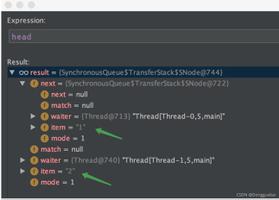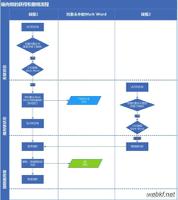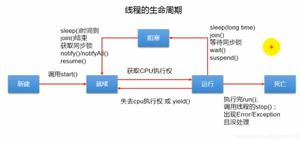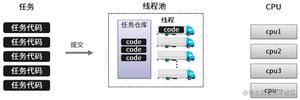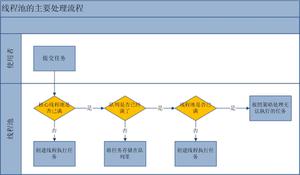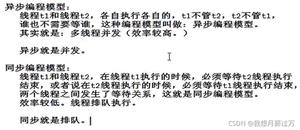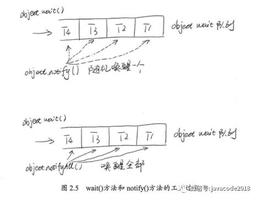Java多线程技术-wait/notify/join

wait()方法的作用是使当前执行代码的线程进行等待,wait()是Object类的方法,用来将当前线程置入预执行队列中,并且在wait()所在的代码处停止执行,直到接到通知或被中断为止。wait()调用前,必须获得该对象的对象级锁,即只能在同步方法或者同步代码块中调用wait()方法,否则会抛出IllegalMonitorStateException。当wait()执行后,当前线程释放锁
notify()方法的作用是用来通知那些可能等待该对象的对象锁的其他线程,如果有多个线程等待,则随机挑选出一个wait状态的线程,对其发出通知,并使它等待获取该对象的对象锁。notify()调用前,必须获得该对象的对象级锁,即只能在同步方法或者同步代码块中调用notify()方法,否则会抛出IllegalMonitorStateException。当notify()方法执行后,不会马上释放该对象的锁,呈wait状态的线程也并不能马上获得该对象锁,要等到执行notify()的线程将程序执行完,也就是退出synchronized代码块后,当前线程才会释放锁。
notifyAll()方法和notify()作用基本是一样的,一个是唤醒全部的wait线程,一个是唤醒其中一个wait线程。
经典案例生产者和消费者
public class MyStack { private List<String> list = new ArrayList<>();
public synchronized void push() {
try {
while (list.size() == 1) {
System.out.println("push:"+Thread.currentThread().getName()+"呈wait状态");
this.wait();
}
list.add("anyString=" + Math.random());
this.notifyAll();
System.out.println("push=" + list.size());
} catch (InterruptedException e) {
// TODO Auto-generated catch block
e.printStackTrace();
}
}
public synchronized String pop(){
String returnValue = "";
try {
while(list.size() == 0){
System.out.println("pop:"+Thread.currentThread().getName()+"呈wait状态");
this.wait();
}
returnValue = list.get(0);
list.remove(0);
this.notifyAll();
System.out.println("pop="+list.size());
} catch (InterruptedException e) {
// TODO Auto-generated catch block
e.printStackTrace();
}
return returnValue;
}
}
public class Product {
private MyStack myStack;
public Product(MyStack myStack) {
this.myStack = myStack;
}
public void pushService(){
myStack.push();
}
}
public class Customer {
private MyStack myStack;
public Customer(MyStack myStack) {
this.myStack = myStack;
}
public void popService(){
myStack.pop();
}
}
public class ThreadCustomer extends Thread {
private Customer customer;
public ThreadCustomer(Customer customer) {
this.customer = customer;
}
@Override
public void run() {
while(true){
customer.popService();
}
}
}
public class ThreadProduct extends Thread {
private Product product;
public ThreadProduct(Product product) {
this.product = product;
}
@Override
public void run() {
while(true){
product.pushService();
}
}
}
public class Test {
public static void main(String[] args) throws InterruptedException {
MyStack myStack = new MyStack();
Product p = new Product(myStack);
Customer c = new Customer(myStack);
ThreadProduct pThread = new ThreadProduct(p);
ThreadCustomer cThread = new ThreadCustomer(c);
pThread.start();
cThread.start();
}
}
View Code
join的作用
join()是Thread类的一个方法,它的作用是使所属的线程x对象正常的执行run方法中的任务,而使当前线程z进行无限期的阻塞,等待线程x销毁后再继续执行线程z后面的代码。
public class MyThread extends Thread{ @Override
public void run() {
try {
System.out.println(System.currentTimeMillis());
Thread.sleep(3000);
} catch (InterruptedException e) {
// TODO Auto-generated catch block
e.printStackTrace();
}
}
}
public class Test {
public static void main(String[] args) throws InterruptedException {
MyThread myThread = new MyThread();
myThread.start();
myThread.join();
System.out.println("在myThread执行完后输出:" + System.currentTimeMillis());
}
}
View Code
测试结果:
1516170164683在myThread执行完后输出:1516170167686
join和synchronized的区别
从上面的例子可以看出,join方法具有线程排队运行的作用,有些类是同步的运行效果。join和synchronized的区别是:join在内部使用wait()方法进行等待,而synchronized是使用“对象监视器”原理做为同步
join(long)和sleep(long)的区别
由于join的内部是使用wait来实现的,所以它具有释放锁的特点,而sleep没有这一特点。
源码如下:
public final synchronized void join(long millis)throws InterruptedException {
long base = System.currentTimeMillis();
long now = 0;
if (millis < 0) {
throw new IllegalArgumentException("timeout value is negative");
}
if (millis == 0) {
while (isAlive()) {
wait(0);
}
} else {
while (isAlive()) {
long delay = millis - now;
if (delay <= 0) {
break;
}
wait(delay);
now = System.currentTimeMillis() - base;
}
}
}
以上是 Java多线程技术-wait/notify/join 的全部内容, 来源链接: utcz.com/z/393933.html


